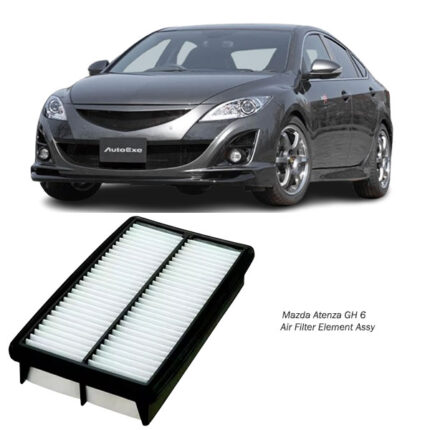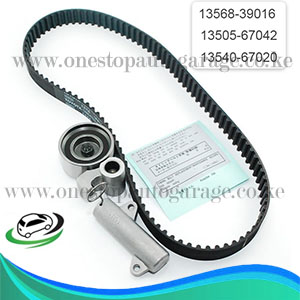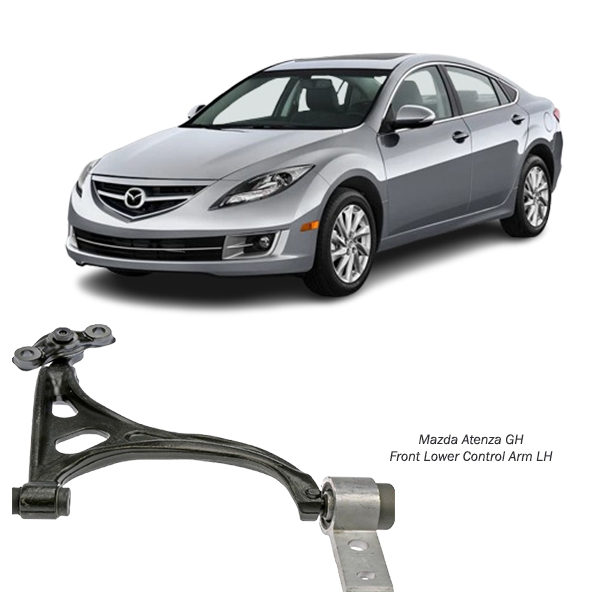-9%
Get Mazda Atenza GH Front Lower Control Arm LH GS1D-34-350D in Kenya
The front lower control arm (LH) is a crucial component in a vehicle’s suspension system. Positioned on the left-hand side (driver’s or passenger’s side, depending on the vehicle’s configuration), this part plays a vital role in maintaining stability, handling, and overall driving comfort. Understanding the function, importance, maintenance, and replacement process of the front lower control arm is essential for ensuring the safety and longevity of your vehicle.
What is the Front Lower Control Arm (LH)?
The front lower control arm, often referred to simply as a control arm, is a suspension component that connects the chassis of the vehicle to the wheel assembly. It allows the wheel to move up and down in response to road conditions while maintaining proper alignment and stability. The LH (Left-Hand Side) designation indicates its placement on the vehicle’s left side.
A typical control arm consists of:
- Metal Framework: A sturdy arm made of steel or aluminum that can withstand high stress.
- Bushings: Flexible rubber or polyurethane inserts that connect the control arm to the chassis, absorbing vibrations and reducing noise.
- Ball Joints: Pivot points that attach the control arm to the wheel hub, allowing steering and suspension movement.
Functions of the Front Lower Control Arm (LH)
- Connects Suspension Components:
- The control arm links the chassis to the steering knuckle or wheel hub, forming a bridge between stationary and moving parts of the suspension system.
- Absorbs Road Impacts:
- By working with the bushings, the control arm absorbs shocks and vibrations caused by uneven road surfaces, ensuring a smoother ride.
- Maintains Wheel Alignment:
- The control arm ensures the wheel maintains proper alignment, which is essential for vehicle handling and tire longevity.
- Facilitates Steering and Stability:
- The ball joint at the end of the control arm allows the wheel to pivot for steering while providing stability during braking and acceleration.
- Distributes Load Evenly:
- It helps distribute the forces generated during driving, such as cornering or braking, to prevent excessive stress on individual components.
Benefits of a Well-Functioning Front Lower Control Arm
A properly maintained front lower control arm offers several advantages:
- Enhanced Ride Comfort:
- By absorbing shocks and vibrations, the control arm contributes to a smoother driving experience.
- Improved Handling and Stability:
- Proper alignment and secure connections ensure consistent handling and vehicle stability under various driving conditions.
- Prolonged Tire Life:
- By maintaining proper alignment, the control arm reduces uneven tire wear, saving you money in the long run.
- Increased Safety:
- Stable suspension and precise steering ensure the vehicle responds correctly to driver input, especially in emergency situations.
- Reduced Noise and Vibration:
- The bushings in the control arm minimize the transfer of noise and vibration to the cabin, creating a more pleasant driving environment.
Signs of a Faulty Front Lower Control Arm (LH)
Control arms are subject to wear and tear due to their exposure to high stress and varying road conditions. Common signs of a failing control arm include:
- Clunking or Knocking Noises:
- These sounds often occur when driving over bumps or making turns and may indicate worn bushings or ball joints.
- Poor Handling:
- A loose or imprecise steering feel can result from a damaged control arm.
- Uneven Tire Wear:
- Misaligned wheels caused by a faulty control arm can lead to irregular wear patterns on tires.
- Vehicle Pulling to One Side:
- A damaged control arm can disrupt wheel alignment, causing the car to veer to one side.
- Excessive Vibration:
- Increased vibration in the steering wheel or cabin can signal worn or damaged bushings.
- Visible Damage:
- Cracks, bends, or rust on the control arm can compromise its structural integrity.
Maintenance Tips for Front Lower Control Arms
Proper care and timely maintenance can extend the lifespan of your control arms and ensure optimal performance:
- Regular Inspections:
- Include control arm checks during routine vehicle maintenance. Look for signs of wear, rust, or damage.
- Protect Bushings and Ball Joints:
- Ensure these components are in good condition, as they are critical to the control arm’s performance.
- Avoid Overloading:
- Excessive weight can strain the suspension system and accelerate wear on the control arms.
- Drive Responsibly:
- Avoid aggressive driving habits, such as sudden braking, sharp turns, or driving over rough terrain at high speeds.
- Replace in Pairs:
- If one control arm is worn, the opposite side is likely in a similar condition. Replacing both ensures balanced performance.
Replacement Process for the Front Lower Control Arm (LH)
Replacing a front lower control arm requires mechanical expertise and specialized tools. Here’s an overview of the process:
1. Preparation:
- Park the vehicle on a flat surface and engage the parking brake.
- Lift the vehicle using a jack and secure it with jack stands.
- Remove the wheel on the side where the control arm needs replacement.
2. Detach the Control Arm:
- Disconnect the ball joint from the steering knuckle.
- Remove bolts securing the control arm to the chassis and subframe.
- Take note of the placement of any washers or spacers.
3. Inspect Related Components:
- Check the bushings, ball joints, and other suspension parts for wear or damage.
4. Install the New Control Arm:
- Position the new control arm and secure it with the appropriate bolts.
- Attach the ball joint to the steering knuckle.
- Tighten all bolts to the manufacturer’s torque specifications.
5. Reassemble and Align:
- Reinstall the wheel and lower the vehicle.
- Perform a professional wheel alignment to restore proper handling and tire wear patterns.
Common Issues and How to Address Them
- Premature Wear:
- Caused by driving in harsh conditions or using substandard parts. Use high-quality OEM or aftermarket components for replacements.
- Misalignment:
- Improper installation can lead to suspension misalignment. Always have the replacement performed by a qualified technician.
- Persistent Noises After Replacement:
- Ensure all bolts are properly tightened and bushings are correctly installed to prevent unwanted noises.
- Rust and Corrosion:
- Apply rust-proofing treatments to the control arm to extend its lifespan, especially in regions with harsh winters.
Materials Used in Front Lower Control Arms
- Steel:
- Durable and capable of withstanding high stress but heavier than alternatives.
- Aluminum:
- Lighter than steel, providing better fuel efficiency and handling, though it may be less durable in extreme conditions.
- Cast Iron:
- Extremely robust but adds significant weight to the suspension system.
Conclusion
The front lower control arm (LH) is a vital component that directly impacts your vehicle’s handling, stability, and comfort. Regular inspections, timely maintenance, and proper replacement can prevent costly repairs and ensure a safe driving experience. Recognizing the signs of wear and addressing issues promptly will not only prolong the lifespan of your suspension system but also enhance overall vehicle performance.
If replacement is necessary, consult a professional mechanic for proper installation and alignment to guarantee optimal functionality. Investing in quality control arms and maintaining them diligently is a small price to pay for the significant benefits they bring to your vehicle’s safety and performance.
Follow us on Facebook for more parts.



